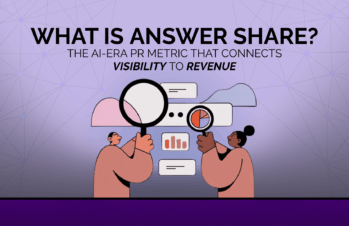It now takes an average of 27 touchpoints to close a sale, compared to 17 touchpoints before the pandemic. This dramatic increase in touchpoints showcases the evolving nature of consumer behavior and the changing dynamics of the buyer’s journey.
The fact that it now takes more touchpoints to convert prospects into customers should be seen as a wake-up call for businesses. It suggests that the path to closing a sale has become more complex and requires a proactive and strategic approach from the very beginning. In other words, you must already be in the closing mindset right from the start of your marketing efforts.
By adopting a mindset focused on closing deals, you ensure that every touchpoint, interaction, and engagement with your prospects moves them closer to making a purchase. Each marketing activity, whether it’s a social media post, an email campaign, a webinar, or a personalized sales call, should be designed to nudge prospects along the buyer’s journey and eventually lead them to a purchase decision.
This shift in mindset encourages businesses to think holistically about their B2B marketing and sales strategies. It prompts them to implement integrated approaches that provide consistent messaging and experiences across various touchpoints, such as content marketing, social media engagement, email nurturing, personalized sales outreach, and more. By aligning your marketing efforts with the closing mindset, you maximize the chances of converting prospects into loyal customers.
PR Shortening the Sales Cycle
When it comes to marketing, public relations (PR) done correctly can shorten your business’s sales cycle significantly.
Earned media placements—such as positive news articles, feature stories, or reviews about your business in reputable publications—can be game-changers in pushing prospects at various stages of the sales funnel closer to making a purchase decision. Here’s how PR can contribute to expediting the sales cycle:
- Influencing prospects at the top of the funnel: At the top of the funnel, prospects may have just become aware of your brand or product. When they encounter positive earned media coverage about your business, it acts as a powerful endorsement from a third-party source. This validation enhances brand credibility and generates initial interest, helping prospects move from being mere bystanders to actively considering your offerings.
- Nurturing prospects at the middle of the funnel: In the middle of the sales funnel, prospects are evaluating different options and conducting research. PR plays a crucial role here by providing social proof and shaping perceptions. Positive media placements showcase your business’s expertise, innovation, or unique value proposition, which can sway prospects in your favor. When prospects see your brand featured in trusted publications, it reinforces their confidence and strengthens your positioning against competitors.
- Driving conversion at the bottom of the funnel: At the bottom of the funnel, prospects are ready to make a decision. Earned media coverage can act as a final push, instilling trust and credibility that helps prospects overcome any lingering doubts. Seeing your business highlighted in the press provides third-party validation, reducing perceived risks and making prospects more inclined to convert into customers.
By leveraging the power of earned media, you harness the influence and authority of trusted publications and journalists. This helps establish your brand as a credible and reliable solution, effectively shortening the sales cycle by expediting the decision-making process. Earned media coverage often reaches a wider audience beyond your immediate network, potentially attracting new leads and expanding your customer base.
Traditional PR vs. Sales-Enabled PR
The moment a press hit goes live is only the beginning of the impact of press coverage. After securing a press hit, sales-enabled PR goes beyond the boundaries of traditional B2B PR to make the hit even more impactful.
Here’s what happens next:
- Amplifying press hits on social media: Social media has great power in extending the lifespan and expanding the reach of press coverage. By strategically sharing and promoting your press hits on platforms like Twitter, Facebook, LinkedIn, and Instagram, the news will continue to resonate with your target audience. Resharing press hits can generate additional engagement, conversations, and potentially more media interest.
- Showcasing press hits on your press page: Your website’s press page serves as a central hub for showcasing your achievements and demonstrating your credibility. Add each press hit to your press page to create a curated collection that displays your media coverage. This highlights your accomplishments and also assures visitors that you have gained recognition from reputable sources, establishing you as the “real deal.”
- Leveraging press hits in sales outreach: Third-party validation is a powerful tool in the sales process. Leverage your press hits by incorporating them into your sales outreach strategy. By referencing and sharing these accolades with potential customers or clients, you can enhance your credibility and strengthen your value proposition. The validation provided by media coverage can significantly influence prospects’ perceptions and help you close deals more effectively.
Press begets press. By making your initial press hits work for you, you create a positive feedback loop that attracts further media attention. Increased visibility and brand awareness are the ultimate goals, and by leveraging the momentum of your press coverage, you can achieve just that.
YouTube’s PR Playbook
For B2B tech companies looking to achieve sustainable success, taking a page out of YouTube’s playbook can be a game-changer. Rather than relying on one-off, massive hits that may or may not materialize, adopting a long-tail strategy can offer a more reliable and effective approach.
So, what exactly is a long-tail strategy? At its core, it involves leveraging niche creators and outlets to generate a continuous and consistent wave of coverage, as opposed to banking solely on a few significant breakthrough moments.
In the context of YouTube, the long-tail strategy is closely tied to the platform’s vast ecosystem of creators and channels catering to specific interests and niches. Instead of solely focusing on partnering with mainstream, high-profile YouTubers with millions of subscribers, a long-tail strategy involves collaborating with creators who have smaller but highly engaged and loyal audiences within specific niches.
By tapping into niche creators and outlets, B2B tech companies can tap into highly targeted and passionate communities. These communities often exhibit a deeper level of interest and engagement in specific topics or areas related to the startup’s product or industry. While the reach of these niche creators may be smaller compared to mainstream influencers, their audience is more likely to be genuinely interested in the company’s offering.
Implementing a long-tail strategy provides several advantages. First, it allows a B2B to tap into multiple touchpoints within its target audience, maximizing exposure and increasing the chances of reaching potential customers. Rather than relying solely on a few big hits, a long-tail approach creates a consistent presence across a variety of channels and platforms.
Second, a long-tail strategy fosters a groundswell of consistent coverage. By partnering with niche creators and outlets, B2Bs can generate a steady stream of B2B content and discussions that resonate with specific communities. This ongoing coverage helps build brand awareness, credibility, and loyalty over time.
Long-tail strategies also mitigate the risks associated with relying solely on a handful of big hits. In the unpredictable landscape of viral content and trends, putting all your eggs in one basket can be risky. By diversifying your marketing efforts and leveraging niche creators, you establish a more stable and sustainable foundation for growth.
To execute a long-tail strategy effectively, B2B tech companies need to identify and engage with relevant niche creators and outlets. This involves conducting thorough research to identify channels, websites, blogs, podcasts, and social media accounts that cater to the target audience and align with the startup’s brand values. Building strong relationships with these niche creators and outlets through collaborations, content partnerships, and sponsored opportunities can help create a network of consistent coverage and engagement.
In-house PR vs. Agency Partnerships
So how can brands execute a sales-enabled PR strategy? One of the key decisions is between hiring in-house PR and marketing professionals or partnering with an agency that specializes in PR and marketing.
When it comes to establishing an in-house marketing team, it’s crucial to evaluate whether your budget and resources can support such an endeavor. This consideration is essential to ensure that you can effectively execute your marketing tactics and drive the desired results.
If your budget and resources can handle an in-house marketing team, it’s time to celebrate! Having an in-house team offers several advantages. They will be dedicated solely to your business, which means they can develop an in-depth understanding of your brand, products, and target audience. They can work closely with other departments, fostering seamless collaboration and alignment. Additionally, an in-house team can provide immediate availability and agility, making it easier to implement real-time changes and respond to emerging opportunities.
However, if an in-house team is not feasible due to a limited budget or resource constraints, there’s an alternative that can provide you with new perspectives and cutting-edge strategies: working with a team of external marketing experts. These experts bring a wealth of industry knowledge, specialized skills, and diverse experiences to the table. They can offer fresh insights and innovative strategies that may be outside the purview of your internal team. Collaborating with external experts allows you to tap into their expertise, benefiting from their deep understanding of the evolving marketing landscape.
Working with an external team also offers flexibility and scalability. You can tailor the engagement to your specific needs and adjust the level of support as your business requirements evolve. This approach allows you to leverage the expertise of professionals who are well-versed in the latest marketing trends, tools, and techniques. It ensures that your strategies stay relevant, effective, and aligned with industry best practices.
By partnering with external marketing experts, you can often access a wider range of services and resources. This includes specialized skills in areas such as search engine optimization (SEO), content marketing, social media management, data analytics, and more. Instead of investing in hiring and training internal resources for these specific areas, you can leverage the expertise of a team that already possesses the necessary skills and tools.
Ultimately, the decision to establish an in-house marketing team or work with external experts depends on your specific circumstances, budget, and goals. Both options have their merits, and it’s important to assess what aligns best with your organization’s needs and capacity.
Media Training
No matter who is in charge of your marketing and PR, once you’ve scored those coveted interviews and press opportunities, you’ll need the right training to showcase your expertise and raise the profile of your brand.
Here are five essential tips to keep in mind:
- Be the voice of your company and emphasize your message: As a representative of your brand, it’s essential to clearly convey your company’s message and values during the interview. Align your responses with your brand’s key talking points and ensure consistency in your messaging. This helps to reinforce your brand identity and ensure that your interview supports your broader marketing and communications objectives.
- Practice, practice, practice: Preparation is key to a successful interview. Find a partner, such as a colleague or a media training professional, and simulate the interview scenario. Practice responding to potential questions about your company, its products or services, and any relevant industry topics. This exercise helps you become more comfortable with the interview process, refine your messaging, and build confidence in your delivery.
- Listen first, then respond: Active listening is crucial during an interview. Pay close attention to the journalist’s questions, making sure you fully understand what they’re asking. Take a moment to gather your thoughts before responding, ensuring that your answers address the question at hand comprehensively. This approach demonstrates your attentiveness and provides the journalist with the information they seek.
- Speak confidently and concisely: Journalists often seek sound bites or impactful quotes for their articles. To provide them with compelling material, speak confidently and concisely. Avoid rambling or providing excessive detail. Instead, deliver your key messages succinctly, using clear and straightforward language. This makes it easier for reporters to extract meaningful quotes and capture the essence of your points.
- Handle tough questions with care: It’s not uncommon to encounter challenging or unexpected questions during an interview. When faced with such queries, it’s essential to handle them thoughtfully. If you need time to gather your thoughts, it’s perfectly acceptable to pause briefly before responding. If you genuinely don’t know the answer, it’s better to admit it rather than provide inaccurate information. Offer to follow up with additional details or resources to ensure accuracy and build trust with the journalists.
Remember, media training is an ongoing process, and these tips serve as a starting point for developing your interview skills. By practicing these techniques, you can confidently navigate media interactions, effectively communicate your key messages, and make a lasting impression on journalists and their readers.
Ready to see how sales-enabled PR can impact your marketing efforts? Reach out.




